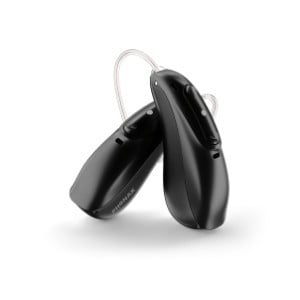Free home visits
with a local audiologist

Head of Online Medical Content

Audiology Expert at Hearing Aid UK
Both the Phonak Audeo Lumity and Oticon Intent are premium hearing aids, making it tough to choose between them. These models come from two of the biggest hearing aid manufacturers out there, with Phonak Lumity released in 2022 and Oticon Intent in 2024.
In this comparison article, we hope to help you decide which is better for your needs, loss, and lifestyle.
The Phonak Lumity and Oticon Intent differ significantly in features, so your choice will depend on your specific preferences. Regardless of the hearing aid, it’s essential to have them fitted and programmed by a professional audiologist.
Style-wise, Lumity comes in rechargeable and disposable battery options, including the Lumity 312, R, RT (with Telecoil), R Life (waterproof), Slim (slim fashion device), and power models. So there is, effectively, a style to suit all hearing loss levels and tastes. Currently, Oticon Intent only offers a rechargeable Receiver in Canal (RIC) model so if you like the Oticon brand and are seeking a disposable RIC alternative - the Oticon Real miniRITE T hearing aid is worth looking at.
You'd miss out on the listening intention you get with Intent, which gives you truly personalised hearing that deals with your distinct requirements. However, Real does include wind and noise handling technology, designed to solve key pains for hearing aid wearers.
On a side note, you might find that the Phonak charging systems are tight for custom ear moulds, whereas Oticon’s chargers have a touch more space. It is also worth noting, that Phonak offers an ActiveVent receiver for better audio in different environments.
That said, wearers still love the power ear moulds from Oticon. These ear moulds have a removable receiver wire which is extremely beneficial as it allows for easy wire length adjustments or replacements if the wire becomes faulty.
In terms of battery and charging, looking at the rechargeable models, both brands use lithium-ion batteries with all-day life on a three-hour charge. However, Oticon's batteries are easy to remove if they need replacing, whereas Phonak’s must be sent to the manufacturer.
This might not matter so much, as generally if a rechargeable battery needs changing it is usually time for an upgrade to better more advanced technology. The average life of a rechargeable hearing aid battery is 4-5 years, chances are you would have already upgraded before then.

On the technology front, Phonak Lumity has four levels (90, 70, 50, 30), while Oticon Intent has three (1, 2, 3). As always, we would recommend choosing the highest level of technology you can reasonably afford. If that's not possible, opt for a lower level within your budget.
It will then be your audiologist's responsibility to maximise the performance of those devices to suit your hearing loss needs. If budget is a priority, the Phonak Lumity lineup offers an additional lower-tier option to help you save some money.
Both brands allow extensive programming adjustments, but Oticon offers more adjustment bands for precise fitting (Phonak 20 and Oticon 24) which should mean your audiologist can mirror your hearing loss prescription better.
In reality, will those extra four bands make a difference? It's hard to be sure but it is good news that more precise adjustments can be made if you prioritise accurately matching your hearing loss prescription.
In general, Oticon excels in high-frequency amplification and matching high-frequency prescriptive targets, which affects the clarity of your hearing aids. Whereas Phonak Lumity is better at customising streamed audio and noise reduction. For example, Phonak’s AutoSense 5.0 automatically adjusts to your environment, while Oticon Real relies on manual programs.
Some argue that whilst Oticon successfully reduces background noise using their algorithms, it doesn't give your audiologist enough adjustments when compared to Phonak. A hearing aid that is good at tackling background noise can make it easier for you to engage in conversations, both in person and over the phone.
It can also help to prevent cognitive decline and give you a better overall quality of life. This type of hearing aid is ideal for those who work in noisy environments, have an active social life, and find they are consistently struggling to hear speech in noise.
If you lead a quiet lifestyle and spend more time in one-on-one conversations, you might not need your hearing aids to filter out background noise as much. If this is the case, perhaps the adjustment options Oticon offers might be enough to make the grade. For comparison, if we take a look at wind and handling noise management, such as touching your hair and other sudden disruptive and uncomfortable sounds, Oticon Intent wins hands down with their RealSound technology.
![]()
When we look at streaming, Phonak offers more controls to adjust streamed audio from phone calls, music, and other media. This means that with the Phonak hearing aid, you can tailor the sound of streamed media to your liking.
Bluetooth connectivity is another area where Phonak Lumity shines, supporting multiple active connections and a variety of devices. Oticon Intent, however, is limited to one active connection and primarily works well with Apple devices.
There are app offerings for both brands, for adjustments and remote care, with Phonak’s MyPhonak app providing arguably more customisation options. Oticon’s Companion app offers a find-my-hearing-aid feature and better compatibility with Apple devices. If you are an Android user, we recommend you ask your audiologist if your current mobile phone is compatible with the latest Oticon requirements.
Durability-wise, Phonak's Lumity Life model especially, is more robust. Both brands have similar accessories like remote microphones and TV streamers, but loyal Phonak fans love how the integrated Roger receivers provide superior assistive listening options.
Oticon developed its sound algorithm using 12 million everyday sounds collected using microphones worldwide. This extensive data allows Oticon Intent to create an algorithm that effectively handles background noise.
Phonak uses directional microphones to focus on the sound in front of the user, which works well in many situations but can result in a less natural sound and a feeling of isolation. Oticon Intent, on the other hand, aims to allow more sound in a way that mirrors natural hearing and now uses a 4D sensor to provide a more customised sound experience.
Both brands offer great sound quality but I would give Oticon the edge with their open sound and advanced sensor technology.
Overall, both of these hearing aids are excellent. However, there are many differences between them, and the best choice for you will depend on your specific hearing loss and personal preferences.
The Phonak Audeo Lumity and Oticon Intent are premium hearing aids with distinct features. Lumity offers multiple styles and rechargeable options, while Intent focuses on personalised hearing. Lumity excels in streaming and noise reduction, whereas Intent is better at wind and handling noise management.
If you're considering addressing your hearing loss for the first time or looking to upgrade your existing hearing aids and can't decide between these two options, freephone 0800 567 7621 and we can support you further.
Do not spend hundreds of pounds without getting a second opinion from us.
 Not only are the prices great, but the service is fantastic! Many thanks to your team.
Not only are the prices great, but the service is fantastic! Many thanks to your team.If you are looking at this page then it is likely that an audiologist has suggested that you purchase this particular hearing aid, so is this the best model for you?
In general, any audiologist will always be recommending to you the model that best suits your needs. Here is a useful checklist to make sure that is the case.
If in doubt, feel free to give us a call. That's what we're here for. In the meantime, read all about our review of the best hearing aids here
If you have significant hearing loss in both ears, you should be wearing two hearing aids. Here are the audiological reasons why:
Localisation: The brain decodes information from both ears and compares and contrasts them. By analysing the minuscule time delays as well as the difference in the loudness of each sound reaching the ears, the person is able to accurately locate a sound source. Simply put, if you have better hearing on one side than the other, you can't accurately tell what direction sounds are coming from.
Less amplification is required: A phenomenon known as “binaural summation” means that the hearing aids can be set at a lower and more natural volume setting than if you wore only one hearing aid.
Head shadow effect: High frequencies, the part of your hearing that gives clarity and meaning to speech sounds, cannot bend around your head. Only low frequencies can. Therefore if someone is talking on your unaided side you are likely to hear that they are speaking, but be unable to tell what they have said.
Noise reduction: The brain has its own built-in noise reduction which is only really effective when it is receiving information from both ears. If only one ear is aided, even with the best hearing aid in the world, it will be difficult for you to hear in background noise as your brain is trying to retain all of the sounds (including background noise) rather than filtering it out.
Sound quality: We are designed to hear in stereo. Only hearing from one side sounds a lot less natural to us.
Fancy some further reading on this topic? You can read about why two hearing aids are better than one in our article, hearing aids for both ears, here
For most people, the main benefit of a rechargeable hearing aid is simple convenience. We are used to plugging in our phones and other devices overnight for them to charge up. Here are some other pros and cons:
For anybody with poor dexterity or issues with their fingers, having a rechargeable aid makes a huge difference as normal hearing aid batteries are quite small and some people find them fiddly to change.
One downside is that if you forget to charge your hearing aid, then it is a problem that can't be instantly fixed. For most a 30-minute charge will get you at least two or three hours of hearing, but if you are the type of person who is likely to forget to plug them in regularly then you're probably better off with standard batteries.
Rechargeable aids are also a little bit bigger and are only available in Behind the Ear models.
Finally, just like with a mobile phone, the amount of charge you get on day one is not going to be the same as you get a few years down the line. Be sure to ask what the policy is with the manufacturer warranty when it comes to replacing the battery.
Looking for more information on rechargeable hearing aids? Read our dedicated page on the topic here
For most people, the answer is yes. But it's never that simple.
The majority of hearing problems affect the high frequencies a lot more than the low ones. Therefore open fitting hearing aids sound a lot more natural and ones that block your ears up can make your own voice sound like you are talking with your head in a bucket. Therefore in-ear aids tend to be less natural.
However the true answer is we can't tell until we have had a look in your ears to assess the size of your ear canal, and until we have tested your hearing to see which frequencies are being affected.
People with wider ear canals tend to have more flexibility, also there are open fitting modular CIC hearing aids now that do not block your ears.
There is also the age old rule to consider, that a hearing aid will not help you if it's sat in the drawer gathering dust. If the only hearing aid you would be happy wearing is one that people can't see, then that's what you should get.
Most people can adapt to any type of hearing aid, as long as they know what to expect. Have an honest conversation with your audiologist as to what your needs are.
Generally speaking, six or more. Unless it's none at all.
The number of channels a hearing aid has is often a simplistic way an audiologist will use to explain why one hearing aid is better than another, but channels are complex and it is really not that straightforward. Here are some reasons why:
Hearing aids amplify sounds of different frequencies by different amounts. Most people have lost more high frequencies than low and therefore need more amplification in the high frequencies. The range of sounds you hear are split into frequency bands or channels and the hearing aids are set to provide the right amount of hearing at each frequency level.
Less than six channels and this cannot be done with much accuracy, so six is the magic number. However, a six channel aid is typically very basic with few other features and is suitable only for hearing a single speaker in a quiet room. The number of channels is not what you should be looking at, it's more the rest of the technology that comes with them.
As a final note, different manufacturers have different approaches. One method is not necessarily better than any other. For example, some manufacturers have as many as 64 channels in their top aids. Most tend to have between 17 and 20. One manufacturer has no channels at all.
Hearing aids are easily lost, misplaced or damaged and typically are one of the most expensive personal possessions an individual can own. We offer hearing aid warranty coverage for £80 per year per aid. Find out more about this service we provide here
All our audiologists use the very latest technology and provide the full range of tests to accurately measure your hearing for free. Find out about what hearing healthcare services we offer all our customers here
Hearing Aid UK offers all their customers free home visiting services, even in a care home environment, for no extra cost. Including hearing tests, fittings, maintenance, check-ups and much more in the comfort of your own home and at your convenience. Find out more information about our home visits here
Here, at Hearing Aid UK, we are dedicated to offering low hearing aid prices. We achieve this by having no head office and low marketing costs. Our hearing aid prices are amongst the lowest you will find anywhere in the world. Explore our prices, brands, and models here
When we refer to a product as 'Latest Launch', we mean it is the latest to be released on the market.
When we refer to a product as 'New', we mean that the product is the newest hearing aid model on the market.
When we refer to a product as 'Superseded', we mean that there is a newer range available which replaces and improves on this product.
When we refer to a product as an 'Older Model', we mean that it is has been superseded by at least two more recent hearing aid ranges.